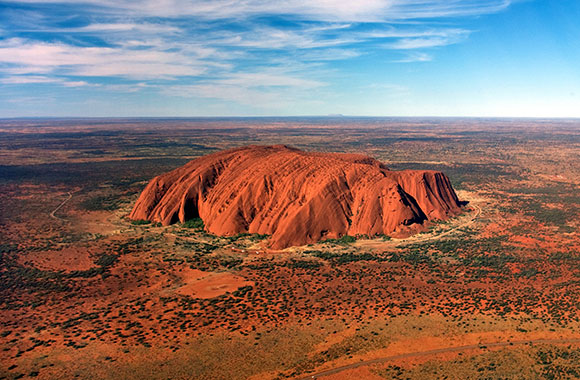
Tours to Uluru and History of Uluru
Rising from seemingly nowhere in the deep centre of Australia, Uluru (Ayers Rock) is one of the world’s great natural wonders. If you are planning to explore Uluru (Ayers Rock) and experience both the physical and cultural significance of this Australian icon, there are many Uluru tours, which offer vehicle hire and accommodation needs.
Naturally Beautiful
Its sheer immensity dwarfs everything around it. Uluru (Ayers Rock) has acquired its reputation not just because it is such a unique landform, but also because of the effect the sun has on its colours and appearance. Sunrises and Sunsets cause changes to its colour from browns though oranges, reds to finally grey.
Cultural & Spiritually Importance
A trip to Uluru (Ayers Rock) is also about experiencing and understanding its cultural and spiritual significance. Both Uluru (Ayers Rock) and Kata Tjuta have great cultural significance for the Anangu traditional landowners. Self discover or take guided Uluru (Ayers Rock) tours that inform about the local flora and fauna, bush foods and the Aboriginal Dream time stories of the area.
History of Uluru
The notes of Uluru National Park explain the Aboriginal understanding of Uluru in the following terms: ‘In the beginning, the world was unformed and featureless. Ancestral beings emerged from this void and journeyed widely, creating all the living species and the characteristic features of the desert landscape you see today.
Europeans
The arrival of Europeans in the area was part of the exploration of the centre during the 1870s. Ernest Giles travelled through the area in 1872 and named both Lake Amadeus and Mount Olga. Giles returned to the area in 1873 but was beaten to Uluru by William Gosse who sighted the monolith on 19 July and named it after the Chief Secretary of South Australia, Sir Henry Ayers.
Aboriginal Reserve
The area was declared the Petermann Aboriginal Reserve in the early 1900s and this existed until the 1940s. Anangu are the direct descendants of these beings and are responsible for the protection and appropriate management of these ancestral lands.
Ayers Rock National Park
Ayers Rock was made a national park in 1950. In 1957 Bill Harney came to the area and in 1958, when the rock was combined with the Olgas to form the Ayers Rock National Park, he was appointed the first official curator. In 1959 a motel lease was granted near the rock and soon after an airstrip was built.
In 1976 the Commonwealth Government set up the lease at Yulara and in 1983-84 the old tourist locations near the rock were closed down. In 1985 the title to the rock was handed back to the traditional owners who, in turn, granted the Australian National Parks and Wildlife Service a 99-year lease on the park.
